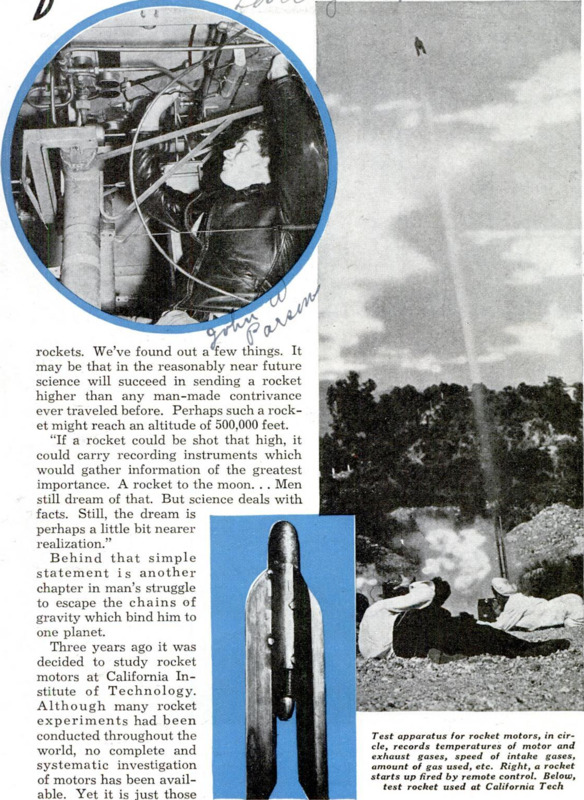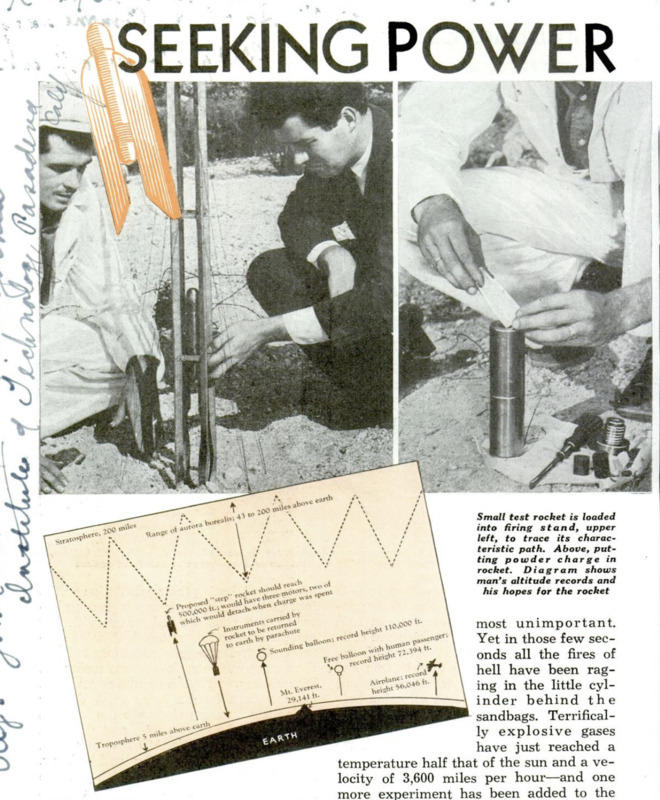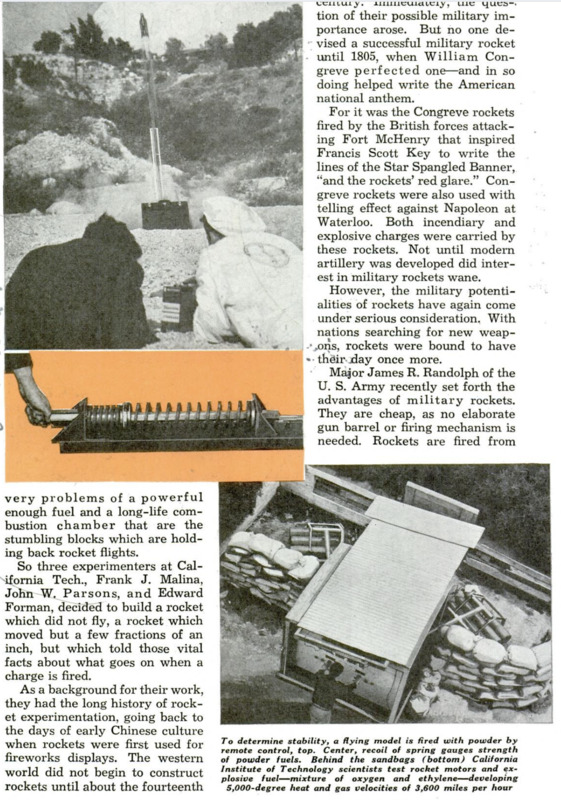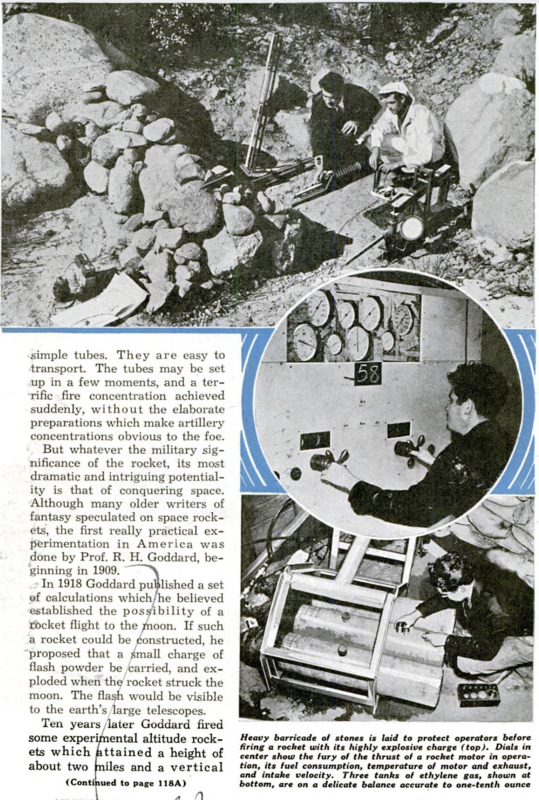GUARDED by sandbags, a man sits before a panel on which are rows of gauges. As he turns valves, needles of the gauges spin and gyrate. From behind the sandbags comes a hiss, a puff of smoke. The man relaxes, the gauges come to rest. If it were not for the tiers of protecting sandbags, it would seem undramatic, almost unimportant. Yet in those few seconds all the fires of hell have been raging in the little cylinder behind the sandbags. TerrificalIy explosive gases have just reached a temperature half that of the sun and a velocity of 3,600 miles per hour - and one more experiment has been added to the long list by which men have sought to gain knowledge which will enable them to conquer outer space. Scientists are hard-headed men. They do not speculate on traveling to the moon every time they see a sky rocket. They say simply: “We are .experimenting with fuels for rockets. We've found out a few things. It may be that in the reasonably near future science will succeed in sending a rocket higher than any man-made contrivance ever traveled before. Perhaps such a rock et might reach an altitude of 500,000 feet. “If a rocket could be shot that high, it could carry recording instruments which would gather information of the greatest importance. A rocket to the moon. . . Men still dream of that. But science deals with facts. Still, the dream is perhaps a little bit nearer realization.” Behind that simple statement is another chapter in man’s struggle to escape the chains of gravity which bind him to one planet. Three years ago it was decided to study rocket motors at California Institute of Technology. Although many rocket experiments had been conducted throughout the world, no complete and systematic investigation of motors has been available. Yet it is just those very problems of a powerful enough fuel and a long-life combustion chamber that are the stumbling blocks which are holding back rocket flights. So three experimenters at California_Tech., Frank J. Malina, John W, Parsons, and Edward Forman, decided to build a rocket which did not fly, a rocket which moved but a few fractions of an inch, but which told those vital facts about what goes on when a charge is fired. As a background for their work, they had the long history of rocket experimentation, going back to the days of early Chinese culture when rockets were first used for fireworks displays. The western world did not begin to construct rockets until about the fourteenth century. Immediately, the question of their possible military importance arose. But no one devised a successful military rocket until 1805, when William Congreve perfected one - and in so doing helped write the American national anthem. For it was the Congreve rockets fired by the British forces attacking Fort McHenry that inspired Francis Scott Key to write the lines of the Star Spangled Banner, “and the rockets’ red glare.” Congreve rockets were also used with telling effect against Napoleon at Waterloo. Both incendiary and explosive charges were carried by these rockets. Not until modern artillery was developed did interest in military rockets wane, However, the military potentialities of rockets have again come under serious consideration. With nations searching for new weapons, rockets were bound to have their day once more. Major James R. Randolph of the U. S. Army recently set forth the advantages of military rockets. They are cheap, as no elaborate gun barrel or firing mechanism is needed. Rockets are fired from simple tubes. They are easy to transport. The tubes may be set up in a few moments, and a terrific fire concentration achieved suddenly, without the elaborate preparations which make artillery concentrations obvious to the foe. But whatever the military significance of the rocket, its most dramatic and intriguing potentiality is that of conquering space. Although many older writers offantasy speculated on space rockets, the first really practical experimentation in America was done by Prof. R. H. Goddard, beginning in 1909. In 1918 Goddard puBlished a set of calculations which he believed established the possibility of a rocket flight to the oon. If such a rocket could be constructed, he proposed that a gmall charge of flash powder be farried, and exploded when the'rocket struck themoon. The flash would be visible to the earth’s large telescopes. Ten years later Goddard fired some experimental altitude rockets which httained a height of about two miles and a vertical climbing speed of 700 miles per hour, far greater than the fastest airplane. Since that time, Goddard has continued his experiments in perfecting rocket design. Recently he incorporated a gyroscope to stabilize his rockets during flight. However, the old problem of a sufficiently powerful fuel and a sufficiently durable firing chamber still remained. Certain experiments seem to favor the use of powder explosives, but in general, liquid fuels seem to offer the best prospects. A comibination of liquid oxygen and gasoline has proved very efficient. Rockets powered by such fuels have been used by the American and German rocket societies. A British society has made speculative plans for space travel should the day ever arrive when fuel and construction problems are licked. This society has designed space suits, and has even made tentative arrangements to secure human beings who would be willing to take the terrific gamble should the conquest of space ever be technically possible. These problems of fuel and combustion chamber the California Tech. Scientists have set out to study - and they have made such advancement that they talk of a sounding rocket which might reach a height of half a million feet. The first problem faced was to design a highly accurate testing machine. Such a device must be able to register thrust, temperature, pressure of gases, amount of fuel used, and the efficiency of the combustion. For experimental purposes gaseous combustibles are used instead of liquid. The propellant now being experimented with is a mixture of ethylene and oxygen. These gases are kept under pressures of 1,200 and 2,000 pounds to the square inch. Operators control the flow of gas by means of valves. The gauges which record the performance of the rocket motor are photographed to give a permanent record. The rocket motor is a single steel cylinder about eighteen inches long and six in diameter. It is lined with carbon to guard against the terrific heat when the motor is operated. A temperature of 5,000 degrees Fahrenheit is sometimes reached - almost half that of the sun’s corona. Rocket motor, tanks of ethylene and oxygen, and connecting tubes are mounted on a torsion balance so delicate that it will register forces of only one-tenth of an ounce, When the motor is fired, motor, lines, and braces move as a single unit. The thrust is then registered by a dial on the control panel. Because of the terrifically explosive character of all fuels used, the control panel and operator are protected from the firing chamber by sandbags. Once a nozzle blew out during a test, and the resulting roar was heard for blocks. Nozzles for the rocket motor are made from such substances as pure carbon, stainless steel, and copper alloys. Experiments have shown that few substances will stand the extreme heat and pressure of the exhaust gases. Velocities of 6,000 feet per second, or better than 3,600 miles per hour, have been recorded. Often after one minute in the firing chamber, a nozzle, which a moment before was a beautifully machined piece of metal, will be charred, ditorted, and blacked, looking as if it had been subjected to the eternal fires. Rocket scientists have calculated that a velocity of seven miles per second, or approximately 25,000 miles per hour, would be necessary for a rocket to escape the earth’s gravity. They further believe that 6,000 tons of fuel would be necessary to carry ten tons of pay load. The California men do not speculate on space travel.However, they do say that their experiments indicate that with a “step” rocket (one having three motors, two of which would be released during flight), a velocity of 11,000 feet per second might be reached. This would carry the rocket to a height of 500,000 feet, five times the record height for a sounding balloon. Physical information gathered by such a rocket would be of incalculable value. Meanwhile, the motor behind the sandbags hisses and thrusts and the needles on the dials continue to write their record of vital facts. And another significant step is being taken in man’s struggle to conquer space.
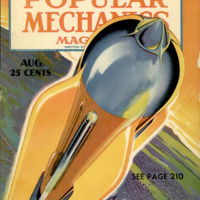 Popular Mechanics, v. 74, n. 2, 1940
Popular Mechanics, v. 74, n. 2, 1940

